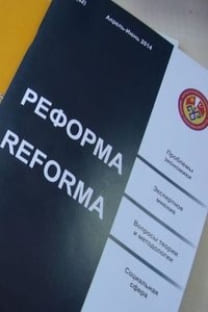VARIATON OF BANKING COST EFFICIENCIES IN CENTRAL ASIA AND MONGOLIA
liberalization, frontier efficiency, banking, Central Asia
VARIATON OF BANKING COST EFFICIENCIES IN CENTRAL ASIA AND MONGOLIA
liberalization, frontier efficiency, banking, Central Asia,
___
- Aigner, D., Lovell, C. K., & Schmidt, P. (1977). Formulation and estimation of stochastic frontier production function models. Journal of Econometrics, 6(1), 21-37.
- Al-Jarrah, I. M., & Gharaibeh, H. (2009). The efficiency cost of market power in banking: a test of the “quiet life” and related hypotheses in the Jordan’s banking industry. Jordan: Investment Management and Financial Innovations.
- Asian Development Bank Institute (ADBI) (2014). Connecting Central Asia with Economic Centers. Kasumigaseki, Japan
- Barra, C., Bimonte, G., & Zotti, R. (2016). On the relationship among efficiency, capitalization and risk: does management matter in local banking market?. Applied Economics, 1-23.
- Battese, G. E., & Coelli, T. J. (1995). A model for technical inefficiency effects in a stochastic frontier production function for panel data. Empirical economics, 20(2), 325-332.
- Berger, A. N., & DeYoung, R. (1997). Problem loans and cost efficiency in commercial banks. Journal of Banking & Finance, 21(6), 849-870.
- Berger, A. N., & Mester, L. J. (1997). Efficiency and productivity change in the US commercial banking industry: A comparison of the 1980s and 1990s (No. 97-5).
- Bonin, J. P., Hasan, I., & Wachtel, P. (2005). Privatization matters: Bank efficiency in transition countries. Journal of Banking & Finance, 29(8), 2155-2178.
- Coleman, B.E., Goffe, V., Perolli, B., Usupova, M., Castillo, L.V., Holzhacker, H., Orlova, N., Sologoub, D., Frewer, G., Hacibedel, B. and Kappeler, A. (2012). Banking in the Eastern neighbours and Central Asia: Challenges and opportunities. Regional Studies and Roundtables, European Investment Bank (EIB).
- Djalilov, K., & Piesse, J. (2011). Financial development and growth in transition countries: A study of Central Asia. Emerging Markets Finance and Trade, 47(6), 4-23.
- Djalilov, K., & Piesse, J. (2014). The determinants of bank efficiency in Central Asia. Corporate Ownership and Control, 12(1), 656-670.
- Dowling, M., & Wignaraja, G. (2006). Mapping Future Prospects to 2015. Central Asia – Caucasus Institute, Silk Road Studies Program, A Joint Transatlantic Research and Policy Center,
- Di Patti, E. B., & Hardy, D. C. (2005). Financial sector liberalization, bank privatization, and efficiency: Evidence from Pakistan. Journal of Banking & Finance, 29(8), 2381-2406.
- Fiordelisi, F., Marques-Ibanez, D., & Molyneux, P. (2011). Efficiency and risk in European banking. Journal of Banking & Finance, 35(5), 1315-1326.
- Fries, S., & Taci, A. (2005). Cost efficiency of banks in transition: Evidence from 289 banks in 15 post-communist countries. Journal of Banking & Finance, 29(1), 55-81.
- Fiorentino, E., Karmann, A., & Koetter, M. (2006). The cost efficiency of German banks: a comparison of SFA and DEA. Available at SSRN 947340.
- Fleming, A., Bokros, L., & Votava, C. (Eds.). (2001). Financial transition in Europe and Central Asia: challenges of the new decade. World Bank Publications.
- Hasan, I., & Marton, K. (2003). Development and efficiency of the banking sector in a transitional economy: Hungarian experience. Journal of Banking & Finance, 27(12), 2249-2271.
- Hahm, H., & Yenier, D. (1998). Financial Sector Reforms ECONOMIC in Mongolia Development. World Bank, EDI Working Papers 18873
- Hicks, J. (1935): “The Theory of Monopoly.” Econometrica, 3, 1–20.
- IMF, (2014). The Caucasus and Central Asia: transitioning to emerging markets, Middle East and Central Asia Department, Washington
- IMF, (2015). Reginal Economic Outlook: Middle East and Central Asia., Washington
- Khalova, G.O., & Talmy, V. (1999). The Banking System and Monetary Policy in Turkmenistan. Russian & East European Finance and Trade, 35, 5, pp. 45-74
- Košak, M., & Zajc, P. (2006). Determinants of bank efficiency differences in the new EU member countries. Financial Stability Report, 29.
- Kraft, E., Hofler, R., & Payne, J. (2006). Privatization, foreign bank entry and bank efficiency in Croatia: a Fourier-flexible function stochastic cost frontier analysis. Applied Economics, 38(17), 2075-2088.
- Khongorzul, D. (2007). Mongolia and Central Asia in Transition. Ritsemeikan Asia Pacific, 3, pp. 117-149.
- OECD, (2011). Competitiveness and Private Sector Development Competitiveness and Private Sector Development: Central Asia 2011 Competitiveness Outlook: Competitiveness Outlook, OECD Publishing
- Pomfret, R. (2009). Central Asia and the Global Economic Crisis. EUCAM policy Brief No. 7, June 2009
- Pruteanu-Podpiera, A., Weill, L., & Schobert, F. (2007). Market Power and Efficiency in the Czech Banking Sector. CNB.
- Sealey, C. W., & Lindley, J. T. (1977). Inputs, outputs, and a theory of production and cost at depository financial institutions. The Journal of Finance, 32(4), 1251-1266.
- Shagdar, E. (2007). Neo-liberal ‘shock therapy’policy during the Mongolian economic transition (No. 0703e). ERINA discussion paper.
- Uyanik, T., & Segni, C. (2001). Evolution of the Banking Sector in Central Asia. Financial Transition in Europe and Central Asia: Challenges of the New Decade, 97.
- ISSN: 1694-5158
- Yayın Aralığı: Yılda 2 Sayı
- Başlangıç: 1999
- Yayıncı: Kırgızistan Türkiye Manas Üniversitesi
FORMULATION OF COMMERCIAL BANKS INTEREST RATES
THE INFRASTRUCTURE OF THE EDUCATIONAL PROCESS OF THE HIGHER SCHOOL
“GOLDEN SCANDAL” AND GOLDEN AGREEMENT: TO THE SOURCE OF CORRUPTION IN KYRGYZSTAN
VARIATON OF BANKING COST EFFICIENCIES IN CENTRAL ASIA AND MONGOLIA
ABOUT SOME ASPECTS OF AGRICULTURE'S STAFFING IN CONDITIONS OF MARKET RELATIONS
KIRGIZİSTAN’DA POLİTİK KONJONKTÜREL DALGALANMALARIN BÜTÇE AÇIĞINA ETKİSİ
SYSTEM OF FINANCIAL STABILITY ASSESSMENT OF BANKING SECTOR BASED ON FINANCIAL SOUNDNESS INDICATORS
TOURISM AS A FORM OF SUSTAINABLE DEVELOPMENT OF MOUNTAIN АREAS IN KYRGYZSTAN
GLOBAL FINANCIAL CRISIS AND ITS ASSESSMENT WITH PERSPECTIVE OF BEHAVIORAL FINANCE
ABOUT SOME ASPECTS OF AGRICULTURE'S STAFFING IN CONDITIONS OF MARKET RELATIONS
